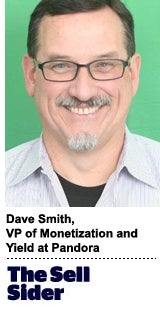 “The Sell Sider” is a column written by the sell side of the digital media community.
“The Sell Sider” is a column written by the sell side of the digital media community.
Today’s column is written by Dave Smith, vice president of monetization and yield at Pandora.
There has been a lot of talk about programmatic audio lately. But where’s the beef? What is the publisher value proposition that’s going to get buyers to move their audio spend from traditional sales channels to a programmatic environment?
There have been many programmatic “solutions” recently offered by a range of publishers, from traditional radio companies to startup streaming services. But if they don’t offer value, they won’t get marketers to move their dollars from traditional buying models to the new programmatic offerings.
But how do they create value to boost demand?
When thinking about programmatic offerings across display and video, I see value being created by four factors, including efficient buying, audience buying, flexibility and measurability.
Creating Value
- Efficient buying reduces the friction associated with starting, planning, changing and transacting around media.
- Audience buying allows buyers to deploy data on their customers and prospects to the advertising they buy to ensure relevance and manage frequency.
- Flexibility provides the scale, platform and medium flexibility to structure a campaign to best achieve the marketer’s objectives.
- Measurability allows the leveraging of emerging tools, such as Moat, VCE and DAR, to ensure that ads are delivered and seen by the right audience
With audio, there is a fifth critical factor: audience engagement. In a perfect world, the ad is delivered in an environment where the listener is truly engaged with the content, making them emotionally open to the message.
Appealing To Marketers
There are multiple ways publishers can address these five factors.
Publishers can create value via efficient buying by directly placing insertion orders from existing buying platforms that leverage traditional audio buying metrics, such as AQH and Cume, to shape buys. Audio should be just one more format available. Billing, reconciliation and payment should be automated to the greatest extent possible.
Publishers can leverage a range of existing platforms, including Prisma from MediaOcean, Strata and even AppNexus, all of which are mature automated buying platforms that manage the relevant audio metrics.
Publishers can also address the audience-buying factor by leveraging investments in data. This may include deploying CRM data, data stored in DMPs and data from third-party sources to target ads to the most relevant audience, ideally shaping different creative for different segments. Publishers should offer a range of formats from seven- to 30- and 60-second spots, based on marketer objectives.
In terms of audience engagement, publishers should extend the trend toward viewability into the audio space by guaranteeing that the ad delivered will be heard by a listener in a mode where they are receptive. That means having an understanding of the ad load the user is facing. Is the ad running along with eight or 10 other ads in one long pod? Or, is it running on its own? Is the format where the ad is running conducive to the emotional goal of the marketer?
Flexibility is important, so publishers need to offer control over the platforms where the ad is delivered, such as on the web, iPhone, tablet or in the car. They additionally need to offer data on both reach and frequency, and provide access to both at scale. Finally, publishers need to offer buyers tools to manage their audio buys as part of an integrated campaign, combining audio with display and video for the greatest impact.
Publishers also need to provide access to the tools marketers need to measure the ads they buy to ensure they’re getting what they pay for. Ad ecosystem players like Moat are extending their viewability and audience verification tools into the audio world to provide measures of audibility and audience verification. But that’s not enough. Audio programmatic won’t really take off until buyers can measure the attribution impact of their campaigns with closed-loop studies by the likes of DataLogix, comScore and Nielsen.
Current Offerings Fall Short
In general, the existing offerings on the market today come up lacking. Most of those offering programmatic audio solutions are focused on the transactional efficiency side, allowing buyers to execute deals through automated buying and scheduling systems. But the products being offered in those systems are generally either broadcast spots, which don’t allow targeting or measurement, or insertions into streams based on audio spots, which don’t provide the listener engagement you would get with limited exposure content streams.
Until publishers can offer real value from an audio programmatic offering, the dollars won’t rush to this space. The market needs solutions that leverage the real value of streaming audio to reach engaged target audiences with personalized messages across platforms with fully measurable outcomes.
That’s the opportunity for programmatic audio. We’re not there yet. But we’re moving there quickly.
Follow Pandora (@PandoraPulse) and AdExchanger (@adexchanger) on Twitter.













